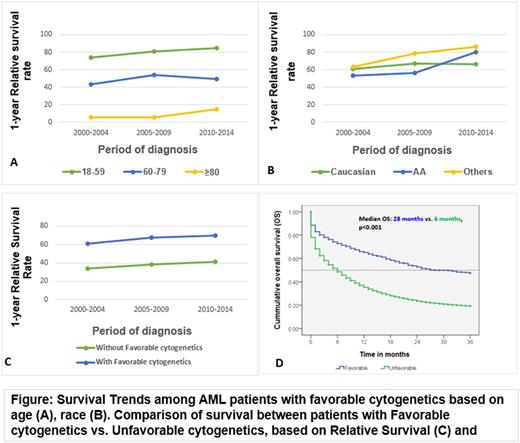Abstract
Background:
Cytogenetics remains the single most important prognostic factor in patients with acute myeloid leukemia (AML). t(8; 21), inv(16) and t(16;16) are the favorable cytogenetic risk groups. Karyotyping not only predicts outcome but also provides an important guidance for therapy. A Southwest Oncology Group (SWOG)/ Eastern Cooperative Oncology Group (ECOG) intergroup study revealed an estimated 5-year survival rates of 55% in this subset of patients [1]. Population based study to estimate survival pattern in this subset of patients is lacking. We conducted this study to evaluate survival rates in AML patients with favorable cytogenetics over 15 years in the United States.
Methodology:
Surveillance, Epidemiology and End Result (SEER-18) database was utilized to identify adult patients (≥ 18 years) with AML (as first primary) with favorable cytogenetics from 2000 to 2014. 1-year relative survival rates (RS) with 95% Confidence Interval (CI) were calculated using SEER stat at different time intervals (2000-2004, 2005-2009 and 2010-2014) and compared utilizing Z-test among different cohorts categorized by race, age and sex. Also, a Kaplan Meier Curve and log rank test were used to compare overall survival (OS) in months between AML patients with and without favorable cytogenetics.
Results:
The database identified 30,618 AML patients. Among them, only 984 patients (3.2%) were found to have favorable risk cytogenetics. Out of these, 554 were males. Median age at diagnosis was 51 years. 785 of them were Caucasian, 82 were African Americans and 113 were from other races.
In all the time periods, younger age at diagnosis was associated with better survival rate (RS for 18- 59 years: 84.8%, CI 79.6-88.7% vs. RS for 60-79 years: 49.6%, CI 39.0-59.3% vs. RS for ≥ 80 years was 14.9%, CI 5.4-28.8% in 2010-2014).
Races other than Caucasian and African American (AA) had better survival than Caucasian or AA. The RS for Caucasian were better than AA for the time period 2000-2004 and 2005-2009. However, AA had better RS compared to Caucasian in the recent years (RS: 80.3%, CI 62.1-90.4% vs. 66.1%, CI 60.4-71.2%).
The survival was significantly better for those with favorable cytogenetics as compared to those without favorable cytogenetics (RS: 69.7%, CI 64.8-74.1% vs. 41.1%, CI 40.1-42.2%; 3-year OS: 47.5±1.7 vs. 19.2±0.2, 2-year OS: 52.8±1.7 vs. 23.5±0.3, 1-year OS: 65.2±1.6 vs. 35.4±0.3 in 2010-2014). And the median OS was 28 months vs. 6 months, p<0.001.
Conclusion:
Most AML patients with favorable cytogenetics achieve a complete response after induction therapy. They continue to remain in long-term remission after consolidation or autologous transplant. Our study demonstrated a significant survival benefit in AML patients with favorable cytogenetics at a population level. Also, the survival rates have increased significantly in recent years. Improved supportive care and increased rate of transplant likely have contributed to this improvement in survival.
References:
Slovak Ml, Kopecky KJ, Cassileth PA, et al. Karyotyoic analysis predicts outcome of preremission and postremission therapy in adult acute myeloid leukemia: a Southwest Oncology Group/ Eastern Cooperative Oncology Group Study. Blood. 2000 Dec 15; 96(13): 4075-83.
No relevant conflicts of interest to declare.
Author notes
Asterisk with author names denotes non-ASH members.


This feature is available to Subscribers Only
Sign In or Create an Account Close Modal